BioLite HeadLamp 750
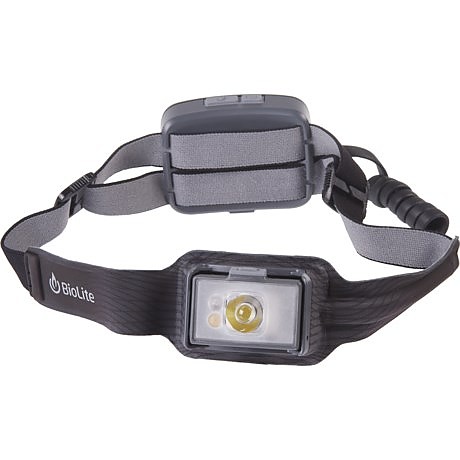
The BioLite HeadLamp 750 is a new full-featured headlamp with capability up to 750 lumens, more than double the maximum output of BioLite's other headlamp models. In addition, the HeadLamp 750 utilizes BioLite's unique and comfortable 3D SlimFit headband design. The HeadLamp 750 has a long lasting 3000 mAh Lithium Ion battery with a unique Run Forever capability that allows external batteries to be connected to the micro-USB charging port.
The BioLite 750 is a full featured headlamp that would be great for hiking, climbing, camping, and more, but even with its significant capabilities, it is still a small and light enough design that you wouldn't hesitate to throw it in your pack for an extended backcountry adventure.
Pros
- Very comfortable to wear for extended periods
- Excellent battery life
- Lighting control—Constant mode vs Regulated mode—works great
- Run Forever Mode—ability to use external power source for pass through charging
- Design look and feel reflective of a pro model
- Red rear-facing lights
- Dimming of all light modes front and back
- Burst mode available in all front light modes and dimming levels
- All buttons front and back very easy to operate
Cons
- It would be nice if the front bezel could be adjusted to more positions than the four in the current design.
Overview
The HeadLamp 750 is BioLite’s newest full featured headlamp design and joins the existing HeadLamp 330 and 200 models to round out BioLite's family of headlamps. The HeadLamp 750 also utilizes the same unique 3D SlimFit headband design as the HeadLamp 330 and 200 models, which allows the headlamp to be very comfortable, light, and compact.
The basic design of the Headlamp 750 consists of a front light module with multiple functions that is connected to a rear-mounted battery pack that incorporates a rear light and charging port. There is a single control button on the front module that allows you to step through the different light options and adjust the intensity of the white and red light. It is also how you can lock the headlamp off to prevent it from accidentally being turned on while in your pack.
There are two control buttons on the rear battery module, one of which controls and allows you to step through the options for the rear red light and a second button enables very special Burst and Constant modes for the front module, which I will get into later in my review.
The rear battery module also contains the micro-USB charging port for the non-removable Lithium Ion battery. This charging port also allows you to connect a user supplied external battery pack that allows pass-through charging, which is a great feature.
I have experienced excellent battery life with over three hours at the highest 500-lumens setting for the white spot light. While the HeadLamp 750 is capable of outputting 750 lumens, that is only for short periods of time utilizing the unique Burst mode. Overall, the BioLite HeadLamp 750 is a full-featured, well thought out, and comfortable to wear headlamp design.
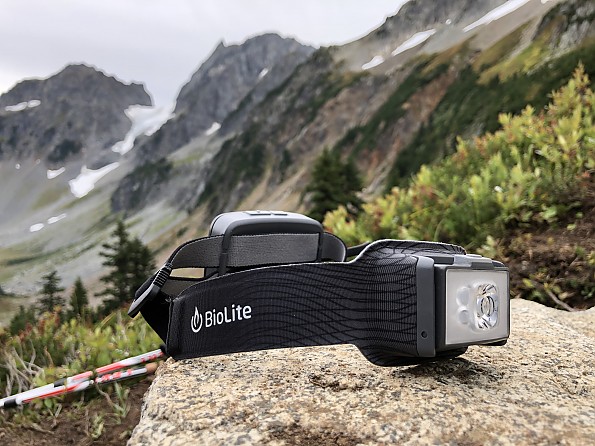
I did want to point out that this review is composed of experience I have had with both a pre-production version of the BioLite HeadLamp 750 and now a production version. I have update this review where appropriate to reflect the final production configuration as currently available. I may provide additional updates in the future with my ongoing experiences with the final production headlamp.
Providing Light
The BioLite HeadLamp 750 has five basic lighting modes with the front facing light: White spot light, White flood, White spot and flood, Red flood, and White strobe.
All of these light modes can be dimmed. The white spot light has a maximum constant brightness of 500 lumens, which should be plenty for just about any headlamp application. But, because more is better, BioLite also incorporated a Burst mode that increases the white spot light up to 750 lumens for up to 30 seconds!
Here is an example showing the HeadLamp 750 set at its highest 750 lumens Burst mode with the white spot light and lowest white light settings. While the primary white light is a spot light profile, it still provides more than adequate light in the surrounding area.

While the Burst mode only lasts for 30 seconds each time you hit the button, it is unique in that it is available while you have any of the front module light modes enabled. So, for example, if you have the red light active and hit the button for Burst mode the front light will switch to the 750-lumen white spot light for 30 seconds, and then after 30 seconds it will automatically switch back to the red light mode.
The following photo is with the white spot at the 500-lumen setting, which is the brightest setting that is available for an extend period of time.
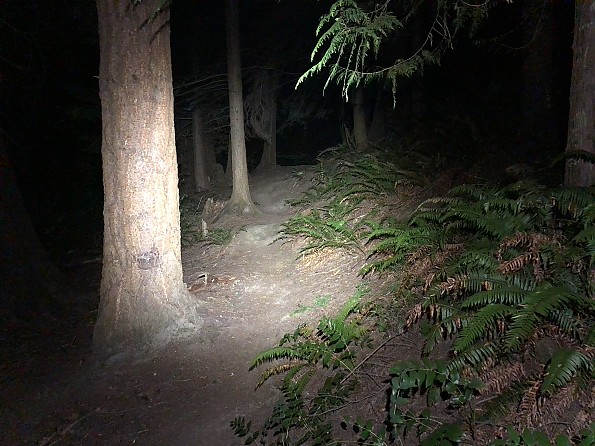
The next picture shows the front white spot light at its lowest 5-lumen setting.
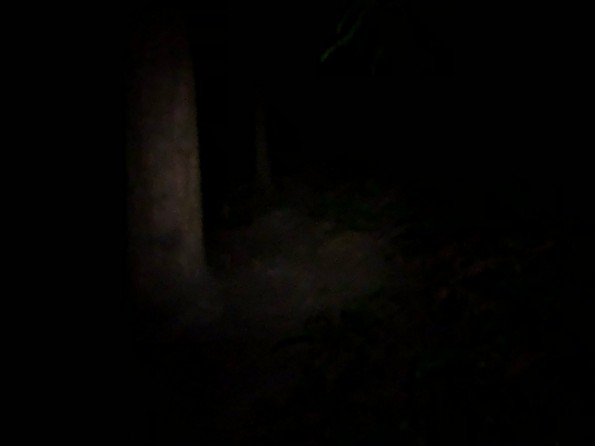
While the picture above of the lowest setting may not seem like enough light, the picture doesn’t reflect the available light and I found that I could comfortably hike the trail on the lowest setting. I am a big believer in trying to maintain your night vision while hiking at night and after your night vision develops, which takes about 30 minutes, you’ll find that you really don’t need much light from your headlamp.
The BioLite 750 also has a white flood light in the front module, and the picture below shows the flood light at its brightest setting. I found that the flood light mode was the most comfortable on my eyes when hiking on a trail at night and is the mode I used the majority of the time.
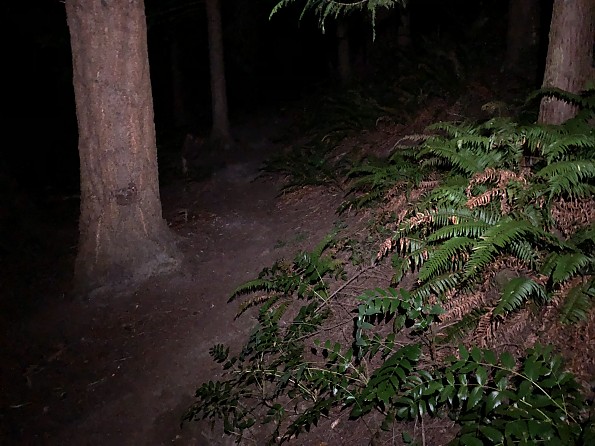
Overall, I think that the BioLite HeadLamp 750 does a great job at its fundament purpose in providing light, and I think it would be a great headlamp for any backcountry, search and rescue, or industrial application, especially with the pass through charging capability that enables you to have light as long as you have external batteries.
The picture below is another example of the 750-lumen Burst mode while my wife and I were heading down to the beach to do some nighttime beach-combing.
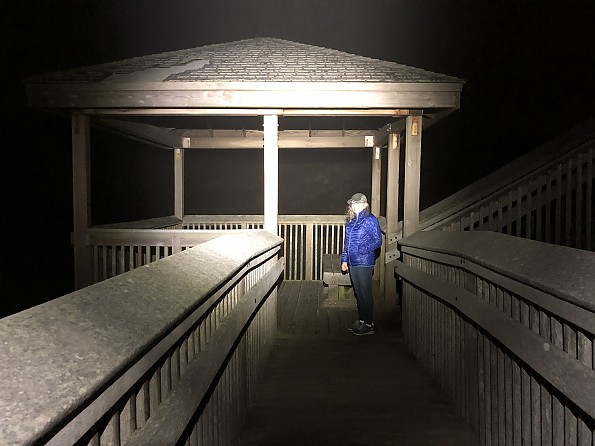
Light Modes and Controls
The BioLite HeadLamp 750 employs the following light modes using the single switch on the front module:
- White Spot
- White Flood
- Combined White Spot and Flood
- White Strobe
- Red Flood
For each of the above modes you also can press and hold the control button to dim the light of that mode from maximum brightness to minimum and then back to full brightness. The system works well and when you reach the full dimmed or maximum brightness the light blinks momentarily. While each of the light modes can be dimmed, BioLite only provides tech specs on the range the white spot can be dimmed, which is 5 lumens to 500 lumens.
The switch on the front module is a nice size, is simple and intuitive to operate, and can be operated with a gloved hand. This switch is also how you lock/unlock the unit when it is stored in you pack by holding it down for eight seconds to either lock or unlock the headlamp.
The rear battery module has two switches as shown in the picture below.

The switch on the left controls the red light on the back of the module which has two modes: solid and strobe. Both of the red light modes can also be dimmed following the same method used with the switch on the front light module.

The switch on the right controls the special Constant and Burst modes on the HeadLamp 750. The Constant mode is activated or deactivated by holding down the right button for five seconds. I go into detail about Constant mode later in my review.
To activate Burst mode for the front light the right button is pressed once. When you go into Burst mode, the front light will change from whatever mode it is in (spot, flood, red, etc.) to the 750-lumen spot light and will remain in that mode for 30 seconds and then will revert back to whatever mode the front light module was in. If you don’t want or need Burst mode for the full 30 seconds you can just press the right button again and it will go out of Burst mode and back into the previous mode the front light module was in.
I really found the Burst mode handy as it was very easy to be hiking along in a very lower power setting and when there was an item of interest where more light was desired it was simple to toggle in and out of Burst mode.
BioLite did a great job with all of the buttons/controls on the Headlamp 750 as they are simple to understand and use.
Fit and Comfort
As stated earlier, the BioLite HeadLamp 750 is configured with a front light module and a rear mounted battery module, and these two modules are connected together by BioLite's unique 3D SlimFit band. The band is nice and smooth on the inner surface and in general provides a comfortable fit.

While I found the 3D SlimFit design of the BioLite 750 comfortable against my head when worn alone, due to the weight of the headlamp I preferred most of the time to wear the headlamp over my hat as it allowed me to keep the tension in the bands looser, but still kept the headlamp from having any movement.

While I'm not a runner, I would not expect a runner to experience much bounce of the front light module given that 60+ percent of the weight of the headlamp is in the rear-mounted battery module.
Here is a picture showing the smooth backside of the headlamp that comes in contact with your forehead.
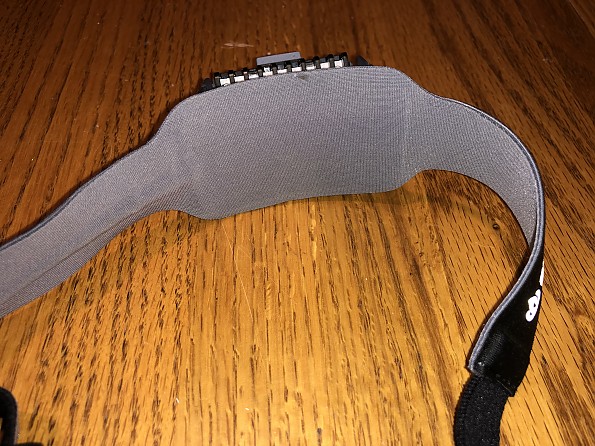
Since I only had the pre-production Headlamp 750 for about a month, I didn’t get as many chances to wear it for extended periods, but I also own a BioLite 200 headlamp that has a similar band design that I have worn extensively and have found it very comfortable. (Update: I now have a production version of the BioLite 750 HeadLamp and will continue to update this review with my longer term experience.)
The headband is also made of what BioLite calls Smart Fabrics that have wicking capability to help keep you cool and dry. If the Smart Fabric ever does get a little grimy from wicking your sweat away, it should be able to be easily cleaned in a sink under running water without risk of damage to the electrical components of the headlamp since they are IPX4 rated.
Adjusting the headband while wearing the HeadLamp 750 is very easy and just involves sliding two unique clips located on each side of the headband near the battery module either toward or away from each other.
Another aspect of the fit of the BioLite HeadLamp 750 is adjusting the angle of the headlamp to a position that works best for you whether you are hiking or reading a book in your tent. The HeadLamp 750 can be adjusted to one of four angled positions as shown in the pictures below.
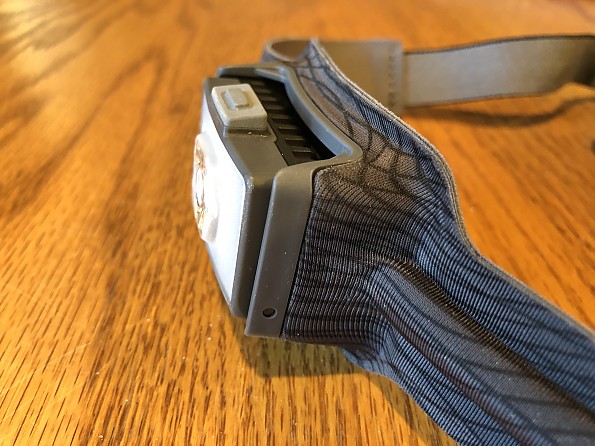
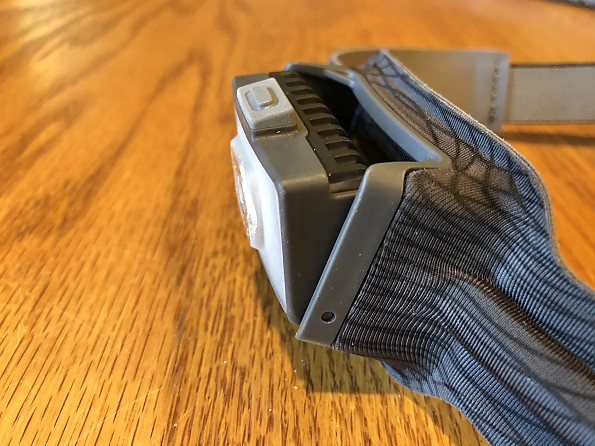
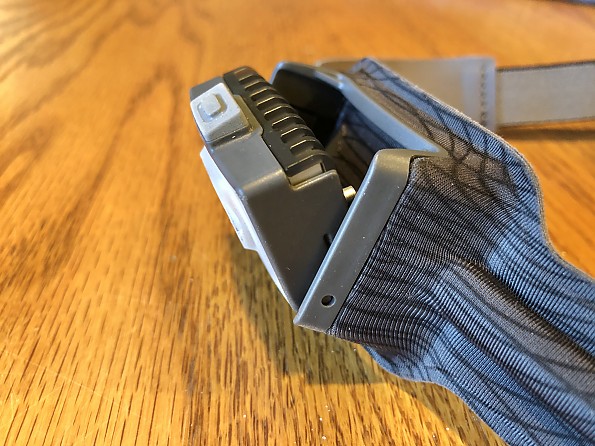
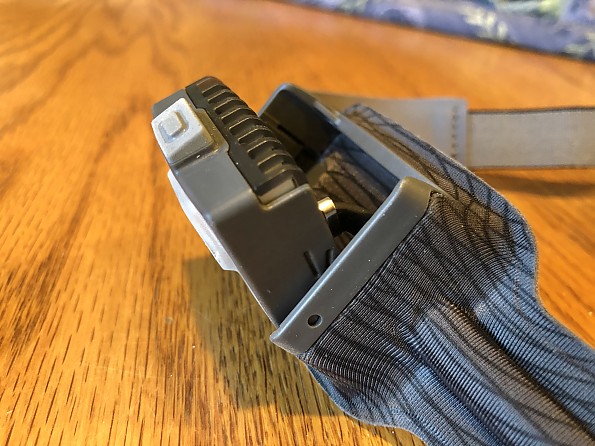
So, depending on the angle of your forehead, the four options may work out just fine, but if you are particular about having your headlamp adjusted to just the right angle you may or may not be happy with the HeadLamp 750.
I have found that I prefer to use the lower intermediate and the all the way tilted out positions most of the time and they seemed to work best for providing light where I needed it.
In the spirit of full transparency I wanted to share something I experienced with the Pre-production version of the BioLite 750 design associated with the pivot for the front light module. While fly fishing on the Crooked River down in Oregon, I pulled the Pre-production version of the Headlamp 750 out of the top compartment of my pack to take the picture below and noticed that the pivot pin on the left side of the front light module had popped out of its hole. I was able to snap it back in place, but I don’t handle my pack that rough, so I was surprised to see this occur.
I now have the final production version of the BioLite 750 design and based on feedback I received from BioLite, they indicated that this issue has been addressed. So I don't anticipate any issues with the production version of the BioLite HeadLamp 750 like I experienced in the picture below, but if I do I'll be sure to come back and update my review.
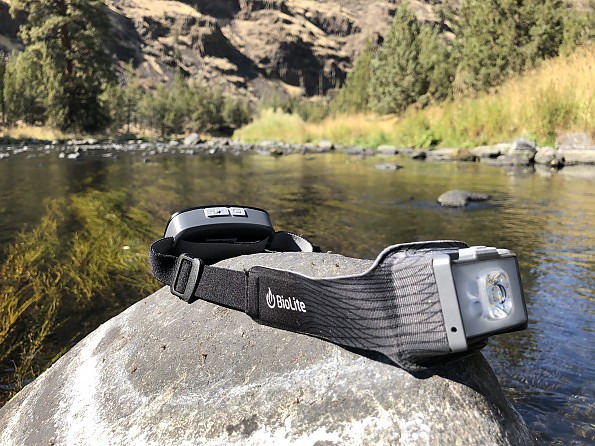
Battery Life and Constant Mode
Due to the limited time I had to evaluate the pre-production BioLite HeadLamp 750, I didn’t get the chance to do extensive testing of the published battery life (I hope to be able to update this review with long-term experience based on further testing of a production model). I did a couple of tests on how long the headlamp would last at the 500-lumen setting in the Constant mode and found that the light would always exceed the two-hour published runtime.
The following table are the published runtimes for the BioLite 750 Headlamp.
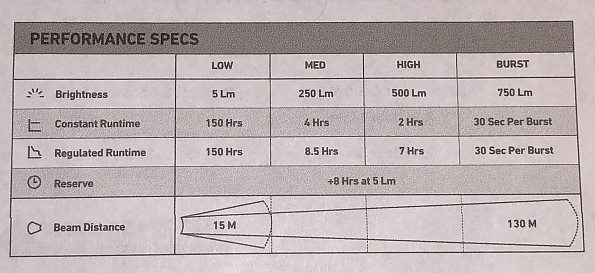
One of the unique features that BioLite included with the HeadLamp 750 is Constant mode. With most typical headlamps the brightness of the headlamp is regulated and will decrease with time. When Constant mode is selected, the HeadLamp 750 will maintain the current light brightness setting for an extended period of time before the light decreases. The figure below from BioLite helps illustrate the difference between Constant mode and the typical Regulated mode.

To select Constant mode you hold down the longer button on the battery module for 5 seconds to switch in and out of the mode. When you are in Constant mode a blue indicator light will be lit to the left of the battery level indicator.

While I didn’t do a number of timed test of the battery life of the HeadLamp 750, I did use it on a number of outings and trips and never had an issue with battery life. Given that the HeadLamp 750 contains a 3,000 man Li-ion battery I don’t think battery life should be an issue, especially since most people will use the headlamp at lower power settings for normal use.
I also have had a BioLite HeadLamp 200 for an extended period now and always found its published performance specs to be very conservative. So I anticipate that BioLite is also conservative with the performance specs they have published for the HeadLamp 750.
Battery Level and Charging the BioLite HeadLamp 750
The HeadLamp 750 charging system is pretty straightforward. The headlamp has a series of four indicator lights that are located on the back of the rear battery module as shown in the picture below. The indicator lights light up whenever a button is pressed showing the remaining battery life with four lights being 100 percent. The lights also come on during charging of the battery, so you will know when the BioLite 750 is fully charged.

Charging the HeadLamp 750 is pretty simple as you can just use the provided 1m long Run Forever USB Type A to micro-B USB cord to charge the HeadLamp 750 from just about any USB port or charger that can provide approximately 1 amp.
The charging port is located on the bottom of the battery module and has a very nice attached rubber plug to seal up the port when not in use.

I did use a small power meter as shown in the picture below to measure the current that the HeadLamp 750 pulls while being charged and found it to be around 1.00 amp regardless of the charging method used.
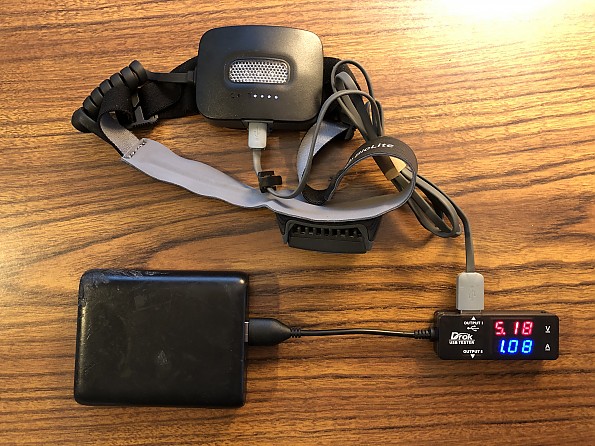
Run Forever Mode/Pass Through Charging
One of the best features of the BioLite Headlamp 750 is the ability to connect the Headlamp 750 to an external battery pack so you’re not limited to the capacity of the integral battery within the headlamp.
To take advantage of this feature you just need to connect the Headlamp 750 to an external battery pack with the supplied Run Forever cord and you’re good to go. The Run Forever cord is 1m long so it's plenty long to enable you to keep the external battery in the top or main compartment of your pack.
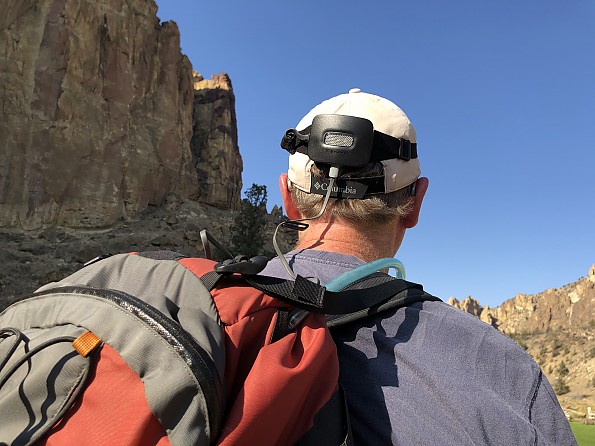
While I didn’t use it in the above picture, BioLite includes a small clip on the Run Forever cord as shown in the picture below, that allows you to clip a loop of the cord to the headlamp headband to help prevent the cord from coming unplugged in use.

When using the Run Forever cord and an external battery, the current being pulled from the external battery is dependent on the light mode in use. I found the maximum current draw to be approximately 1.67 amps when I had an external battery connected and selected the highest output 750-lumen Burst mode.
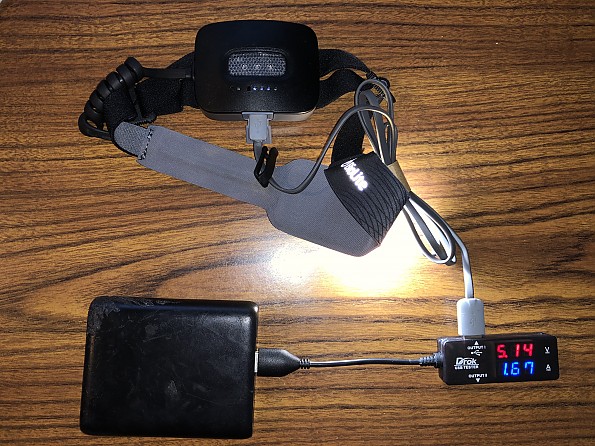
Waterproofness
A headlamp is the type of gear that you really can’t afford to not have work when you run into various weather conditions on a backcountry trip. The BioLite HeadLamp 750 takes those potential adverse weather conditions into account and is designed to an IPX4 Water Resistance standard.
What is IPX4? Well, it is an Ingress Protection Code to IEC standard 60529. The first two are just stating that this is an Ingress Protection rating. The third character is the rating for solid intrusions like dust or sand and the “X” means that the Headlamp 750 has not undergone any testing for sand and dust. The fourth character is for water resistance and the “4” in the IPX4 rating means that the BioLite Headlamp 750 has been tested against splashing or sprayed water from any angle for some period of time.
So the IPX4 rating on the HeadLamp 750 should be more than adequate for a headlamp used for most outdoor activities, but it may not survive being dropped in a creek, which would require an IPX6 or 7 rating, which include submersion in water.
While all this technical talk may be interesting to some, I decided to do my own unofficial test. For the period of time I had the headlamp to test and evaluate I never ran into any rain so I decided to set up a mini rainstorm in my backyard using a garden hose. I attached the HeadLamp 750 to my climbing helmet and set the white spot light on the 500-lumen setting, set the spray head on my garden hose to mist, and then left the helmet and headlamp in the spray as shown in the picture below for a solid two hours.

The HeadLamp 750 seemed to take it in stride and didn’t have any issues, so I think my real world test is a good indicator that the HeadLamp 750 lives up to its IPX4 rating.
What’s Included
The BioLite HeadLamp 750 comes packaged in a very environmentally friendly package made entirely from paper products which is very nice to see.
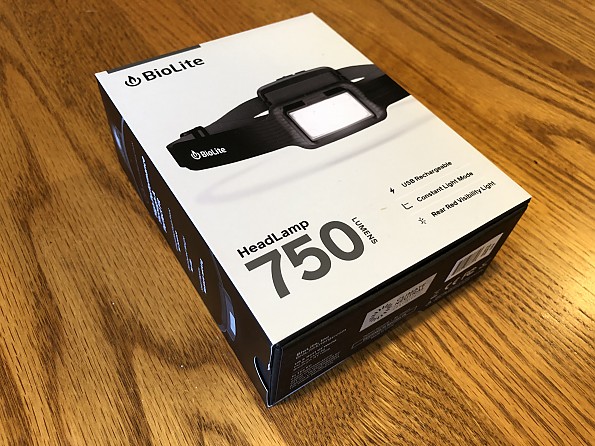
The packaging is very well done and inside the package BioLite shares information on its mission to help deliver renewable energy solutions to individuals living beyond the grid, which I found interesting.

The BioLite HeadLamp 750 comes with the headlamp, a 1m Run Forever Cable which is a basic micro USB to USB charging cable (but very nice quality), an instruction sheet and a Before First Use card. The headlamp doesn’t include a USB charger which shouldn’t be an issue for 99.99 percent of the people out there.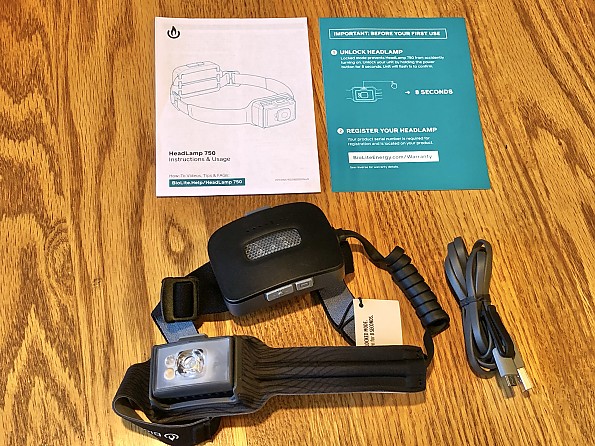
The instruction sheet included is very easy to read and covers all of the functions of the BioLite HeadLamp 750 in a simple and easy to follow format.

I measured the weight of the headlamp at 5.3 ounces, which is right in line with the published weight of 5.3 ounces. The battery module weighs about 3.5 ounces, so it results in 66 percent of the weight of the headlamp resting on the back of your head and only about 34 percent on the front.
The instruction sheet does a good job of giving you all the information you need to operate the headlamp, but if you need more info BioLite has some very nice videos on their website and here at this link.
The HeadLamp 750 also comes in two different colors: Midnight Grey and Moss Green.
Price
The list price for the BioLite 750 is $99.95, which seems fair given that the headlamp is designed for just about any application and conditions (-4 to 122 degrees F) and has the unique Run Forever, Burst, and Constant mode features.

Summary and Recommendation
The BioLite HeadLamp 750 is a light, comfortable, and very bright full-featured headlamp design that provides all the functions needed in a headlamp. The rechargeable design was very well done with significant life/performance from the internal battery, and the Run Forever feature makes this an ideal headlamp for any situation or application where you need to operate for extend periods. In addition, I think that once most people try the Constant and Burst mode features, they will find it hard to go back to headlamp designs without them.
Even though I had a limited time to review the pre-production HeadLamp 750 for my initial review, I think that it is a solid design that provides significant capability in a small package. I wouldn't hesitate to recommend the HeadLamp 750 to anyone looking for a good robust headlamp to take hiking, climbing, hunting, and to support search and rescue activities. In addition, I think the rear red light will be appealing to bikers and groups that like to hike at night.
I have recently been provided a production version of the BioLite 750 HeadLamp. I'll make sure to come back and update this review with anything that I think would be helpful based on my longer term experience.
Many thanks to both Trailspace and BioLite for the opportunity to evaluate and test the HeadLamp 750 for the Trailspace Gear Review Corps!
Background
This review is combination of experience I had with evaluating a pre-production sample of the BioLite HeadLamp 750 for about a month late this summer and now a production version that I will use for an extended period.
I have owned and used headlamps since the mid 1970s and have experience with old 4 D-cell Justrite headlamps up to the latest LED designs available today.
Source: received for testing via the Trailspace Review Corps
(Pre-production sample for testing and review provided by BioLite and returned to BioLite / Production model provided for long-term testing)
A decent premium headlight
Pros
- Big lights
- Big battery
- USB charging
Cons
- Like all, controls are too finicky
- Always lock it when not in use
- No overhead strap (not good for jogging)
- Big battery is bigger than most situations require
I had lost my comparable BD headlamp (a smaller version of BD's Icon 700?)
I enjoy not needing batteries.
The battery pack is pretty chunky.
I had to improvise an overhead strap for running—successful? tbd
Cheers - gs
Background
Mostly a BD guy, but couldn't find a USB-charge version carried in my regular store, so I went with the Biolite. Not a big fan of AAA versions.
Source: bought it new
Price Paid: +120 CAD - Alberta
After fly in baggage—die
I took my Biolite 750 into luggage and fly. After I arrive, get my baggage, come home, and see Biolite 750 flashing twice blue every 3 second and front button not work, like iPhone button not work when power off.
I think, ok! Let’s go charging, but I connect charge and blue flashing still flash. I leave it for hours... After I try to start and more restart and press any button, all button, but hi is done.
Many review for excellent light but nobody don’t say—problem. I use this rubbish 3 times in night fishing for 2 months. Pay 90£—and better I buy 100 aaa headlamps and change every day 2 of them. It’s better than buy one for 90 and use three times.
Source: bought it new
Price Paid: 90£
Your Review
Where to Buy
You May Like
Specs
| low | medium | high | burst | ||
|---|---|---|---|---|---|
| Price |
MSRP: $99.95 Current Retail: $57.73-$99.95 Historic Range: $39.99-$99.95 |
||||
| Brightness | 5 Lm | 250 Lm | 500 Lm | 750 Lm | |
| Constant Run Time | 150 hours | 4 hours | 2 hours | 30 seconds per burst | |
| Regulated Run Time | 150 hours | 8.5 hours | 7 hours | 30 seconds per burst | |
| Reserve |
+8 hours at 5 Lm |
||||
| Beam Distance | 15m | - | - | 130m | |
| Weight |
5.3 oz /150 g |
||||
| Water Resistance |
IPX4 |
||||
| Battery |
3000 mAh Li-ion USB rechargeable |
||||





